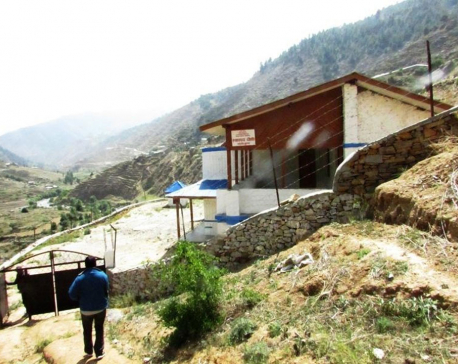
OR
Critical health care centralized in capital
Published On: December 31, 2016 07:35 AM NPT By: Bishnu Prasad Aryal
'About 80 percent of ICU beds are in Kathmandu Valley'
KATHMANDU, Dec 31: Most of the hospitals outside Kathmandu lack modern facilities, with intensive care units (ICU), trained health workers and equipment concentrated disproportionately in the capital city.
"More than 75 percent of hospitals in the country do not have any ICU. Some 95 percent of government hospitals are also without ICU services," said a high ranking official at the Ministry of Health (MoH), requesting anonymity. "About 80 percent of ICU beds are in the hospitals of Kathmandu Valley."
An estimated 450 or so ICU beds are in operation across the country. Officials, however, said that hospitals haven't maintained standards at the ICUs.
"The cost of setting up an ICU bed with basic equipment ranges from Rs 1 million to Rs 3 million. An ICU facility must be a 24-hour service and there should be a ventilator at each bed along with experts, resident anesthetists and third class to first class-level trained health workers at hand and a nurse-bed ratio of 1 to 1. There should also be oxy-meters, tracheal tubes, vacuum devices, monitors, ECG machines, syringe pumps, emergency drugs and special type beds," said Ram Bikram Adhikari, deputy controller (public health) at Tribhuvan University Teaching Hospital (TUTH).
"ICUs cannot be imagined without ventilators but many hospitals with ICUs here do not meet these essential requirements."
He added that the average survival rate at the ICU at TUTH is around 70 percent but the national rate is different.
Just 18 ICUs in the Valley (38 percent) have in-house medical officers, according to details learnt at MoH.
Though no guidelines have been formulated for the ratio of nurses to patients at ICUs in Nepal, a large majority of ICUs have a 1:2 to 1:4 nurse to patient ratio, admitted officials at the Association of Private Health Institutions of Nepal (APHIN).
Officials said lack of well-equipped ICUs, trained health workers, essential equipment and suitable rooms have made it difficult for the general public to avail critical health care services.
TUTH has some 600 beds with 11 core ICU beds and another 29 critical care beds.
According to ministry data, Nepal has 16.7 ICU beds per one million people.
The data showed that of the 51 hospitals in Kathmandu with over 50 bed capacity, only 33 (65 percent) have ICU facilities. Eleven of these are government hospitals, eight are community hospitals and 32 others are private hospitals.
ICUs tackle serious health issues such as electric shock, poisoning, post-surgical complications with viral and bacterial infections and coronary disease.
According to the data, there are only 48 ICUs, with 331 ICU beds between them, or 4.7 percent of the total number of hospital beds. There were only 161 ICU beds with facilities for mechanical ventilation, and these comprise only 2.3 percent of the total number of hospital beds.
With the population of Kathmandu Valley totaling 2,179,171, according to the census of 2011, there are only 15.2 ICU beds per 100,000 population and only 7.2 ICU beds with ventilators per 100,000 persons.
There are 109 government hospitals in the country, with a total of 5,271 beds, and 154 private hospitals with 7,394 beds. According to existing provisions, at least 10 percent of beds should be allocated for emergency services and at least 5 percent for ICU services.
Due to shortage of hospitals, people have been deprived of basic treatment facilities and even critical cases have to wait days or weeks for admission even to the general wards . "We are still at a primitive stage in terms of delivering health services," said Adhikari.
Services in government hospitals are not sophisticated enough while private hospitals are intent more on making money, said officials.
"We provide an ICU bed at Rs 1,000 per day while private hospitals charge up to Rs 30,000," said Adhikari.
Spokesperson at MoH Bhogendra Raj Dotel said that the critical care units in the country are in a sorry state. "Various constraints including lack of necessary laws, human resources, infrastructure, vision on the part of policymakers and leaders, and the working style of the government are major reasons behind the failure to ensure efficient service delivery," he said. "Monitoring, evaluation and the punishment system are also weak."
Out of 35,000 plus sanctioned posts at hospitals and health centers and institutions across the country, more than 21,000 are vacant, according to MoH.
You May Like This

Do these to stay healthy
Most of us are already aware about matters of personal hygiene and self-care. However, despite all the precautions, we tend... Read More...

Health workers threaten to shutdown health services in Jumla
JUMLA, June 8: Health workers said that they’d be forced to disrupt all health services in Jumla if the government... Read More...

Ministry of Health suspends 18 health workers for obstructing Polio vaccine program
KATHMANDU, March 5: Ministry of Health on Sunday suspended 18 health workers, including three district health office chiefs, on the... Read More...





Just In
- MoHP cautions docs working in govt hospitals not to work in private ones
- Over 400,000 tourists visited Mustang by road last year
- 19 hydropower projects to be showcased at investment summit
- Global oil and gold prices surge as Israel retaliates against Iran
- Sajha Yatayat cancels CEO appointment process for lack of candidates
- Govt padlocks Nepal Scouts’ property illegally occupied by NC lawmaker Deepak Khadka
- FWEAN meets with President Paudel to solicit support for women entrepreneurship
- Koshi provincial assembly passes resolution motion calling for special session by majority votes






_20220508065243.jpg)






Leave A Comment